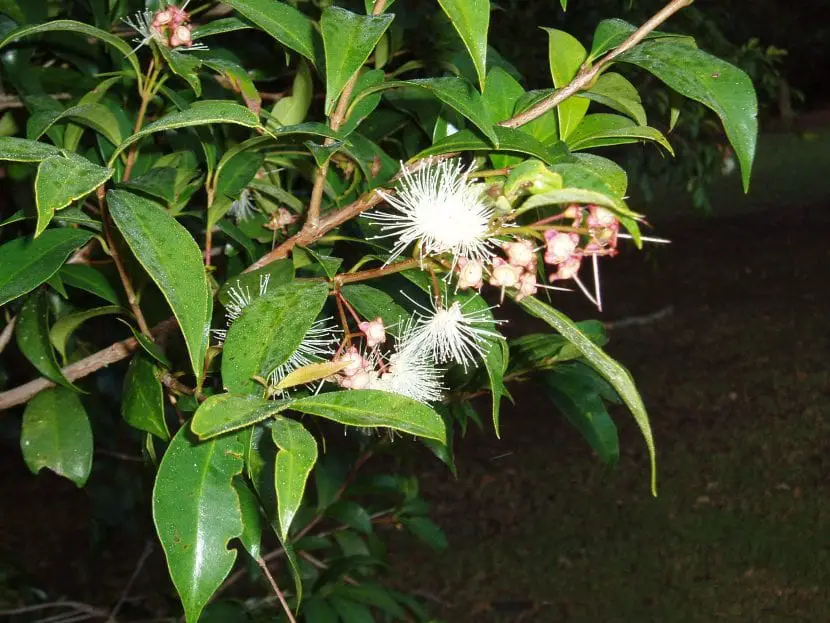

Image – Wikimedia Commons / Fæ
There are plants that, in addition to being beautiful, can be very useful to us. A clear example is the horticultural, that is, those that are usually grown in orchards. Within this group there are many known species, but also others that are interesting to discover, such as the Eugenia myrtifolia.
This is a fantastic tree suitable for areas where the climate is warm or even temperate that produces edible fruits of a very showy color. Know more….
Origin and characteristics of Eugenia myrtifolia


Image – Flickr / John Tann
Our protagonist is an evergreen tree native to Australiawhere it lives in the humid forests that enjoy a temperate climate. Its current scientific name is Syzygium paniculateso the above, Eugenia myrtifoliahas become a synonym. It is popularly known as a magenta cherry, which refers to the color that its fruit can acquire.
Reaches a maximum height of 15 meterswith a thin trunk of up to 35 centimeters, which makes it perfect to have in medium gardens. The leaves are opposite, 3-9cm long, more or less obovate in shape, dark green on the upper side and lighter on the underside. The flowers are white and are grouped in clusters, and the fruits are more or less elongated, usually magenta in color, but they also appear white, pink or even purple.
What are their cares?
If you dare to have a copy, we recommend that you provide it with the following care:
Location
The magenta cherry is a plant that it has to be outside. The right place will be one where it receives direct sunlight all day, although it can adapt and grow well in semi-shade.
Although it does not have invasive roots, if you want to have it in the garden it is important that it be at a distance of about 4-5 meters from walls and others, in order for it to grow normally.
Earth
- Flower pot: it is advisable to fill it with substrate for urban garden (for sale here!) as it is rich in organic matter and has good drainage. But it would also be valid to use universal substrate, mulch, or compost if it is mixed with 30% perlite, claystone or similar.
- Garden: the garden soil must be equally fertile, with good drainage.
Irrigation


Image – Wikimedia Commons / John Tann
Irrigation is one of the most difficult tasks for anyone to master. It is not just pouring water: it is much more. If it is watered excessively, the roots will rot, and on the contrary if it is watered little, they will dry out. Likewise, if the aerial part (leaves, stems, flowers) gets wet and at that moment the sun is giving them, burns will appear immediately.
When and how should we water the Eugenia myrtifolia? Well, the frequency will depend on the climate: the warmer and drier, the more often the waterings will have to be. During the summer, about 3 weekly waterings may be necessary, but the rest of the year it will be watered less since the earth takes longer to lose moisture.
Water must be added to the soil or substrate, not to the leaves or flowers.
Subscriber
It has to be paid from early spring to late summer with a regular contribution of compost, mulch or other organic fertilizer. Let’s remember that its fruits are edible, so it is better to use natural products and not compounds (chemicals). If you choose to use the latter, read and respect the indicated security period, since this way you will be able to know when to pick and consume the fruits without taking risks.
Multiplication
The Eugenia myrtifolia multiplies by seeds in spring. For this, it is interesting to first place them in a glass with water for 24 hours to hydrate, and then sow them in seedbeds (pots, milk or yogurt containers, …) with soil rich in organic matter that facilitates the rapid drainage of the water, as the substrate for seedbeds for example (for sale here!).
Planting or transplanting time
In springwhen the risk of frost has passed. If you have it in a pot, move it to a larger one every 2 or 3 years, when you see roots grow out of the drainage holes.
Pruning
You don’t really need it, but remove all those dry, diseased or weak branches at the end of winter. This way, it will look prettier .
You can also take the opportunity to trim branches that are growing too much, especially if you have it in a pot.
Rusticity
It resists frosts of up to -7ºC.
What uses is given to Eugenia myrtifolia?


Image – Wikimedia Commons / Alexander Bayer Size
Ornamental
As we have seen, it is a decorative plant and quite easy to care. It can be grown in a pot or in the garden, even as a bonsai.
Culinary
Its fruits are ediblewhose acid taste similar to that of apples. So they can be served as a dessert, or eaten as a snack.
And if you prefer, you can make jams with them .
What did you think of this plant? Did you know her?
